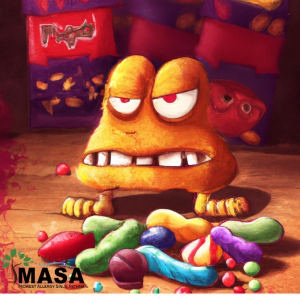Halloween can be a challenging time for families with children who have food allergies. However, with proper precautions, your child can still have a fun and safe Halloween experience. Here are some things to consider and tips for ensuring a happy Halloween for children with food allergies:
- Educate Your Child: Ensure your child knows the importance of not eating any candy or treats without first checking with you. They should understand the potential risks and how to avoid them.
- Read Labels Carefully: If your child does receive candy, always read the labels to check for any potential allergens before allowing them to eat it.
- Teal Pumpkin Project: Look for houses with teal pumpkins or signs. This is an initiative where households offer non-food treats for kids with food allergies or dietary restrictions. You can also participate by placing a teal pumpkin outside your house and offering non-food treats.
- Carry an EpiPen: If your child has severe allergies, always have an epinephrine auto-injector on hand when trick-or-treating.
- Avoid Homemade Treats: Even if they come from trusted neighbors, there’s a risk of cross-contamination.
- Have a Candy Swap: After trick-or-treating, allow your child to swap out candies they can’t have for safe alternatives you’ve bought in advance.
- Host Your Own Event: Consider hosting a Halloween party or event where you can control the food and activities, ensuring a safe environment for your child.
- Prepare Neighbors in Advance: If you’re close with your neighbors, consider giving them allergy-friendly treats in advance to hand out to your child when they come by.
- Wear a Medical Alert Bracelet: This can be especially important for kids who might be trick-or-treating without their parents.
- Communication: Before heading out, have a talk with your child about the importance of communicating any issues they may feel. This includes any physical discomfort or feeling left out.
- Safe Treats: Consider buying allergy-friendly treats and candies in advance so your child doesn’t feel left out.
- Educate Others: Take this time to educate friends, family, and even teachers about the importance of food allergy awareness. Share resources and maybe even fun, safe recipes.
- Consider Non-Food Activities: Halloween isn’t just about candy. Consider other fun activities like pumpkin carving, costume parades, haunted houses, or movie nights.
- Check for Hidden Ingredients: Some candies may not have obvious allergens listed on the wrapper. For example, many chocolate candies are produced in facilities that also process nuts, which might not be explicitly mentioned on the individual candy wrapper.
Remember, the goal is to ensure your child feels included and safe. With a bit of preparation and creativity, Halloween can be a fun experience for everyone, regardless of dietary restrictions.





